
|
Astronomy Picture Of the Day (APOD)
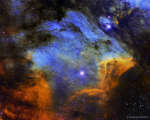 The Pelican Nebula in Gas Dust and Stars
The Pelican Nebula in Gas Dust and Stars
17.11.2015
The Pelican Nebula is slowly being transformed. IC 5070, the official designation, is divided from the larger North America Nebula by a molecular cloud filled with dark dust. The Pelican, however, receives much study because it is a particularly active mix of star formation and evolving gas clouds.
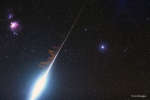 A Blazing Fireball between the Orion Nebula and Rigel
A Blazing Fireball between the Orion Nebula and Rigel
16.11.2015
What's happening to that meteor? A few days ago, a bright fireball was photographed from the Alps mountain range in Switzerland as it blazed across the sky. The fireball, likely from the Taurids...
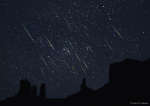 Leonids Over Monument Valley
Leonids Over Monument Valley
15.11.2015
There was a shower over Monument Valley -- but not water. Meteors. The featured image -- actually a composite of six exposures of about 30 seconds each -- was taken in 2001, a year when there was a very active Leonids shower.
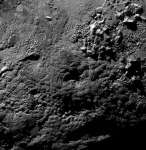 Wright Mons on Pluto
Wright Mons on Pluto
14.11.2015
Long shadows are cast by a low Sun across this rugged looking terrain. Captured by New Horizons, the scene is found just south of the southern tip Sputnik Planum, the informally named smooth, bright heart region of Pluto.
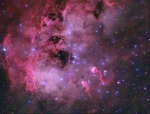 The Tadpoles of IC 410
The Tadpoles of IC 410
13.11.2015
This telescopic close-up shows off the otherwise faint emission nebula IC 410. It also features two remarkable inhabitants of the cosmic pond of gas and dust below and right of center, the tadpoles of IC 410. Partly obscured by foreground dust, the nebula itself surrounds NGC 1893, a young galactic cluster of stars.
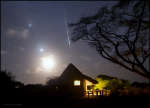 Kenya Morning Moon, Planets and Taurid
Kenya Morning Moon, Planets and Taurid
12.11.2015
On November 8, a waning crescent Moon joined the continuing parade of planets in Earth's morning skies. Captured here from Amboseli National Park, Kenya, even the overexposed moonlight can't washout brilliant Venus though, lined up near the ecliptic plane with faint Mars and bright Jupiter above.
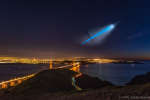 An Unexpected Rocket Plume over San Francisco
An Unexpected Rocket Plume over San Francisco
11.11.2015
What is that unusual light in the sky? A common question, this particular light was not only bright but moving and expanding. It appeared just as the astrophotographer and his friend were photographing the Golden Gate Bridge in San Francisco, California against a more predictable night sky.
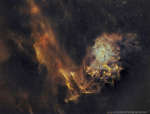 AE Aurigae and the Flaming Star Nebula
AE Aurigae and the Flaming Star Nebula
10.11.2015
Is star AE Aurigae on fire? No. Even though AE Aurigae is named the flaming star, the surrounding nebula IC 405 is named the Flaming Star Nebula, and the region appears to have the color of fire, there is no fire.
 Assembly of The International Space Station
Assembly of The International Space Station
9.11.2015
It is the largest and most sophisticated object ever built off the Earth. It has taken numerous spaceflights and over a decade to construct. The International Space Station (ISS) is currently the premiere habitat...
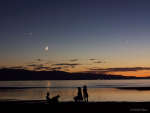 A Quadruple Sky Over Great Salt Lake
A Quadruple Sky Over Great Salt Lake
8.11.2015
This was a sky to show the kids. All in all, three children, three planets, the Moon, a star, an airplane and a mom were all captured in one image near Great Salt Lake in Utah, USA in early September of 2005.
|
January February March April May June July August September October November December |
|||||||||||||||||||||||||||||||||||||||||||||||||